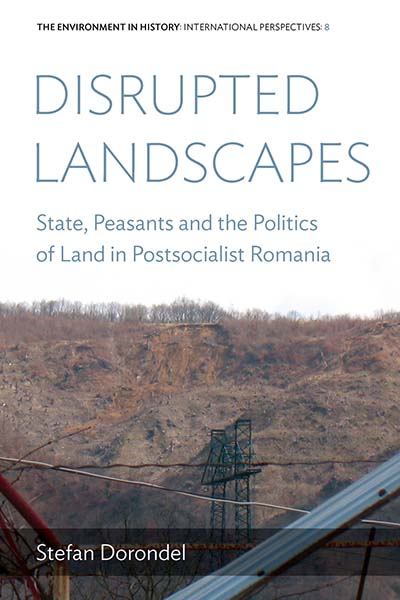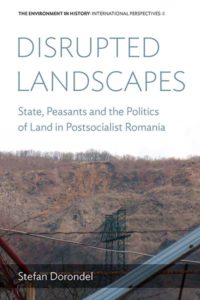
Disrupted Landscapes: State, Peasants, and the Politics of Land in Postsocialist Romania by Stefan Dorondel
 This is part of our special feature, Diversity, Security, Mobility: Challenges for Eastern Europe.
This is part of our special feature, Diversity, Security, Mobility: Challenges for Eastern Europe.
Disrupted Landscapes is a valuable contribution to the study of environmental politics of Romania generally, and to an understanding of the transformations of land relations since the fall of the Golden Age era specifically. As the title suggests, we learn significant information about the workings of power in rural areas and the social and political mechanisms behind them. The volume brings together in one resource Dorondel’s impressive quantity of work on the topic of the transformation of the agrarian landscape of postsocialist Romania during the transition from collectivization to privatization. Of particular interest is Dorondel’s case study, focusing on the ecological and socio-economic transformation in two communes, Dragova and Dragomiresti, Arges County, located in the former historical province of Romania named Valachia. Dorondel’s stated intention is “to guide the reader through the history of land use and the local economy” in order “to describe the changes in the landscape” (25).
In addition to Dorondel’s original contribution to the study of The Agrarian Question in Southeast Europe, attempting “to delineate the commonalities of the agrarian question in South-Eastern Europe in historical perspective” (Dorondel and Serban, 2014, 15), Disrupted Landscapes is a project that deserves special attention. This book is part of “The Environment in History: International Perspectives” series, Volume 8, with a particular emphasis on European research. The book consists of seven chapters covering information regarding significant changes in the national political economy of Romania after the fall of the communist regime. Introducing neoliberalism into the Romanian landscape had significant consequences, such as the new regimes of ownership, as well as the dramatic changes in the natural environment. In addition to the Preface, in which the author explains his intention for writing this book and the difficulties he encountered navigating through disciplines he was not very familiar with, as well as his indebtedness to many people and institutions, an Introduction presents details regarding the postsocialist land reform, which led to the break-up of collective farms and land restitution to private owners, as well as the consequences for the landscape. Explaining the methods used for studying the state and the agrarian landscape, Dorondel insightfully points out the choice of a “bricolage of approaches” for his research in order to explore the unintended outcomes of land reform (18). These and the additional sections of this publication also offer important historical background regarding the changes in land property rights and in agrarian relations experienced by the Romanian provinces in the past two centuries, or especially connected with the communist era. All these add value to Dorondel’s original text and greatly facilitate its perception by the contemporary reader.
As a highly qualified anthropologist and historian scholar, Dorondel is well-equipped and prepared to cope with this task. He provides a solid overview regarding the two centuries of ecological and socio-economic transformations of his selected fieldwork areas, the communes of Dragomiresti and Dragova, respectively. In this respect, Dorondel points out the reasons for guiding the reader through two centuries of local history, linking the changes in the agrarian landscape to the political and economic changes, as well as their close interdependence, showing that agriculture and forestry in the area were part of a national economy beginning in the nineteenth century. While Dragova, with its cool climate on the border of the Carpatian Mountains, large green pastures, and dense forests expressed a visible private ownership, Dragomiresti, a hilly commune, suitable for the forest, natural pasture, and the growing of fruit trees, especially, was collectivized. Consequently, the commune’s landscape was dramatically altered, certain crops, previously an integral part of the local economy, having less importance or completely disappearing. Dorondel emphasizes not only the new orientation of the collectivized agriculture but also the harshness of the collective farm experienced by the workers, together with aspects of the economic scarcity and the oppression of local authorities. The issue of the continuous scarcity of labor is one of the main points of this section, focusing on the aging and feminization of agriculture followed by the use of the outside workforce (soldiers, students, industrial workers, clerks) for harvesting. The comparison between the collectivized and uncollectivized villages clearly distinguishes their spatial organization, in natural resources, economic coordinates, and ecological features.
Writing a full-length book, containing a meticulous analysis of the transformations taking place in rural Romania after the 1989 revolution, is a complex and difficult task and Dorondel should be commended for attempting to achieve the “impossible” in less than 250 pages. It is not surprising how many of Dorondel’s keen observations are so relevant today, at a time of greater changes for Romania, such as its European Union (EU) and NATO membership. The brief analysis of the large-scale reorganization of society and nature brilliantly emphasizes the postsocialist political movement from planned economy to market economy. The new economic, political, and legislative changes, leading to the land and forest restitutions, as well as the privatization of industry and natural resources and the liberalization of the national market, clearly imposed neoliberal values on the Romanian rural people. His discussion of the powerful position of the local elites, bureaucrats abetting illegal deforestation, villagers disputing forests (against the national parks), the illegal building of new houses on communal pasture, and changing the economy of the village from animal husbandry to rural tourism, as well as the expansion of built-up areas on agricultural land, is especially important in this regard. When it comes to analyzing land fragmentation, Dorondel has discovered not only that the peasants have very fragmented land properties, but also that they do not rely entirely on agriculture as a result of the expansion of the industrial sector. This aspect of double economic engagement, with both the land and non-agricultural activities, is not singular in those communes under consideration, but rather a historical feature, part of the political economy of the socialist state.
One of the most distinguishing features of this volume is the analysis of water resources as an important part of the landscape, but a neglected topic in the literature on postsocialism transformation. Dorondel gives special attention to the history of the local river, Argeselu River, which has shaped its architecture, from using the wooden fork, a traditional but illegal fishing tool, to the growing number of water mills, artificial lakes, and ponds in the nineteenth century, to massive constructions for regularization of the river flow during the communist era, and to the constant degradation of the river since 1989. Although looting the river of two of its natural components, sand and pebbles, throwing garbage on the riverbank, and polluting the water by the private chicken complexes, as well as the previous analyzed examples of illegal deforestation, are facts for which those people must be penalized by law, it seems not only to be a socially acceptable behavior but, most importantly, an unacceptable lawless period together with a crass environmental ignorance of both the villagers and the local government. It is true that, as part of the accession negotiations with the EU, waste management is continuously taken into consideration in Romania, but the priority is on the urban areas. There is no doubt that the rural areas have significant financial difficulties and, for many local officials, economic concerns outweigh those of environmental damage. Yet, the reconfiguration of property rights and a reckless decentralization policy on the country scale made the river’s bank an unbearable landscape, being, in many other cases, the real causes that favored this dramatic environmental degradation. Thus, Dorondel’s book has, indeed, occupied a very peculiar position with respect to the factual situation on the ground.
The book is an original contribution to the study of environmental politics, due to the fact that its largest portion is devoted to a matter of state, frequently referred to as the local characteristics. Dorondel concentrates on the everyday life of the ordinary citizens and their struggle to achieve a life worth living. This very well-written and thoroughly researched book is an important addition to the collection of not-so-numerous books on the politics of land in Romania, together with valuable comparison analyses of the similar development in other postsocialist countries in Eastern Europe. Dorondel also offers us an impressive list of references, adding a valuable rendition of the selected number of sources in English. Adding even more value to Disrupted Landscapes are the statistical data, maps, and selected illustrations. The volume should be of interest to both general readers and specialists in that it covers a very broad range of issues placed within a large comparative framework. It also suggests a potential research theme for graduate students. Despite the fact that some of the problems are currently solved in Romania, this book still provides significant examples of alarming environmental issues, as it is easy to understand that Daragomiresti and Dragova are not singular cases. Consequently, I consider imperative a version of this valuable book in Romanian, if it has not already been translated, and copies sent to the Government and Parliament of Romania and/or the local governmental offices, hoping to stimulate their interest in better legislation and more careful environmental protection of the Romanian territory. In Romanian or in English, with the existence of this book in the academic Romanian libraries, I can say that the book will achieve its principal mission of trying to revive the fading interest of the academic communities in this important matter.
Reviewed by Georgeta Stoian Connor, Georgia Gwinnett College
Disrupted Landscapes: State, Peasants, and the Politics of Land in Postsocialist Romania
by Stefan Dorondel
Publisher: Berghahn
Hardcover / 252 pages / 2016
ISBN: 978-1-78533-120-6
To read more book reviews, please click here.
Published on December 6, 2017.




